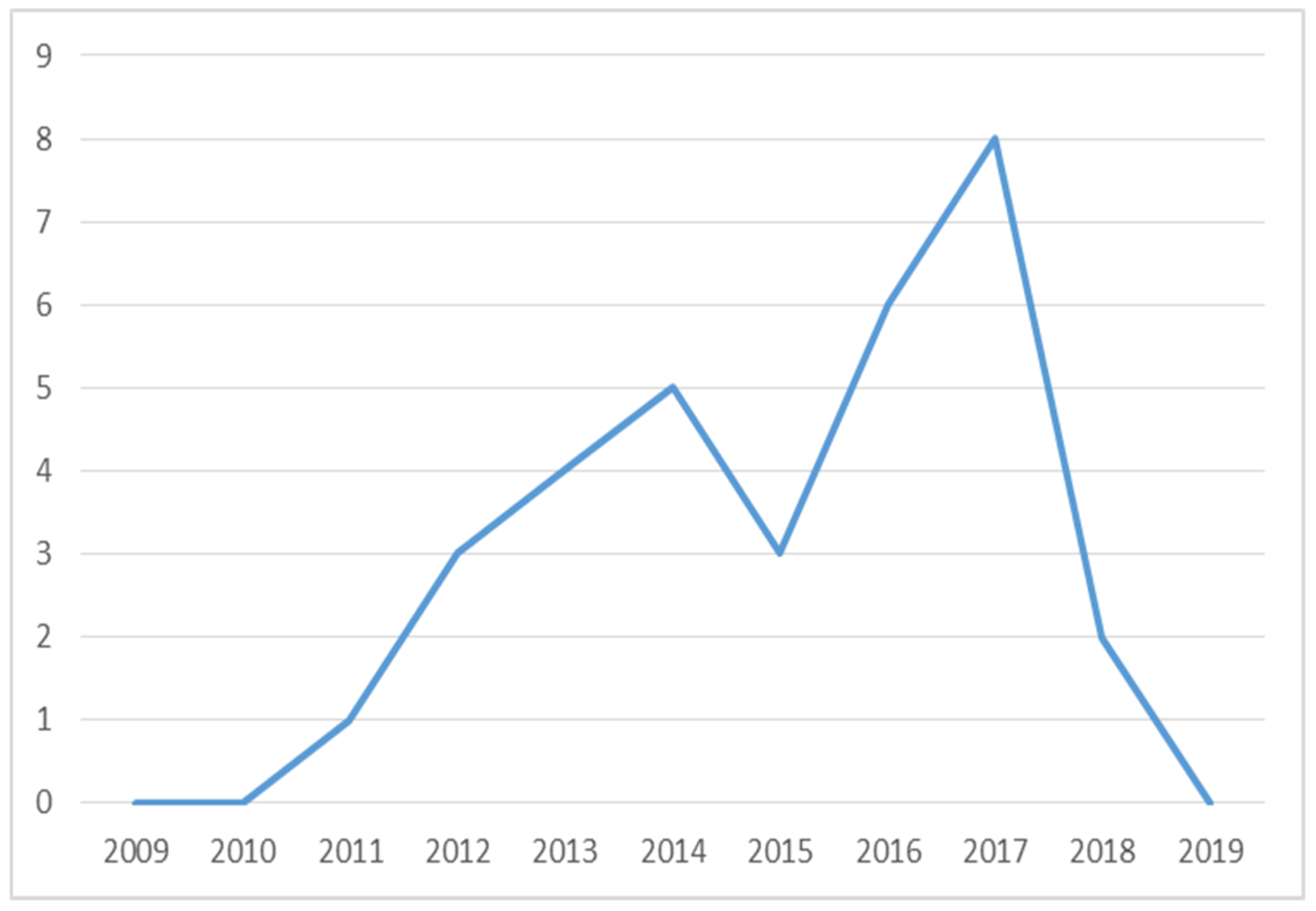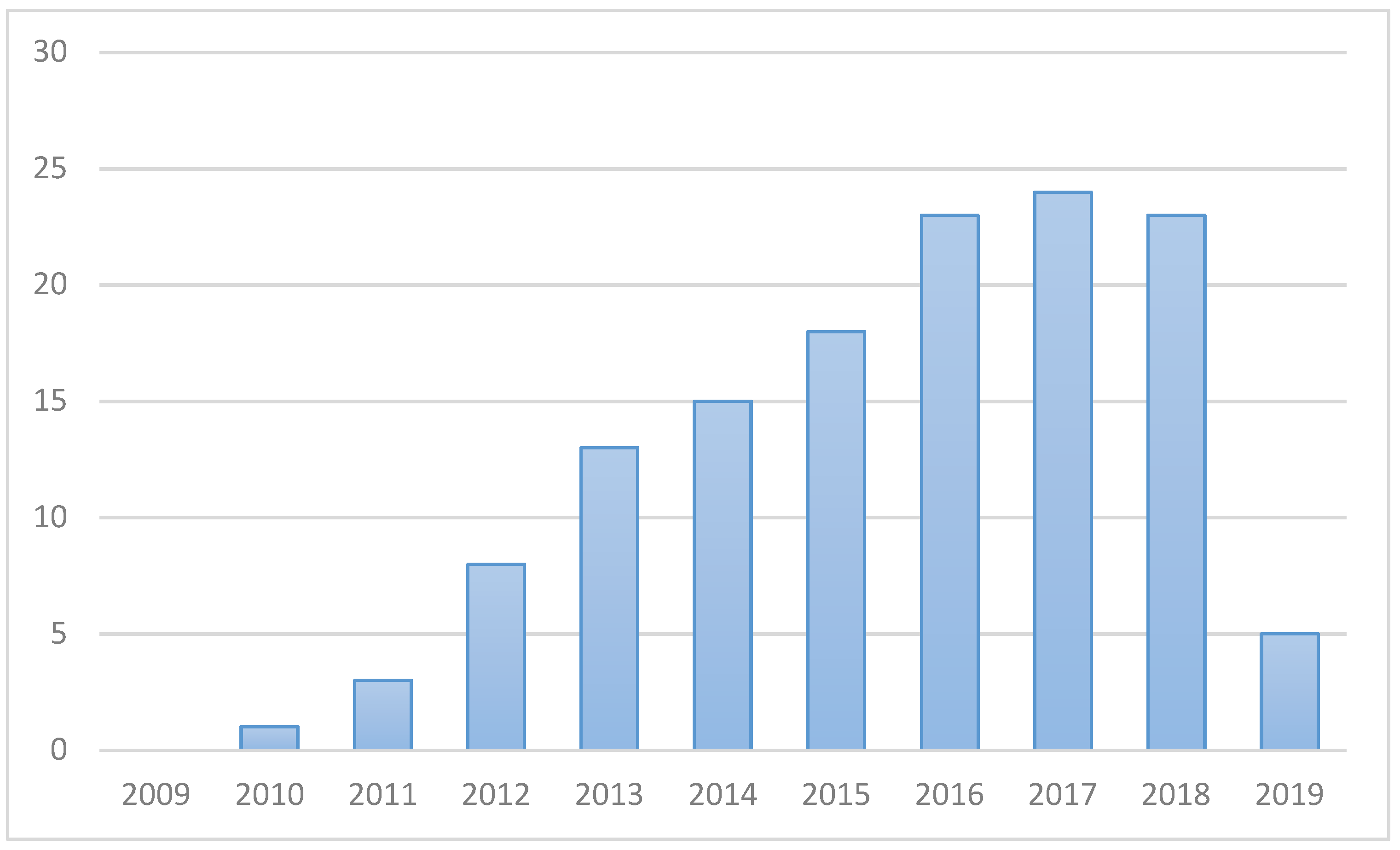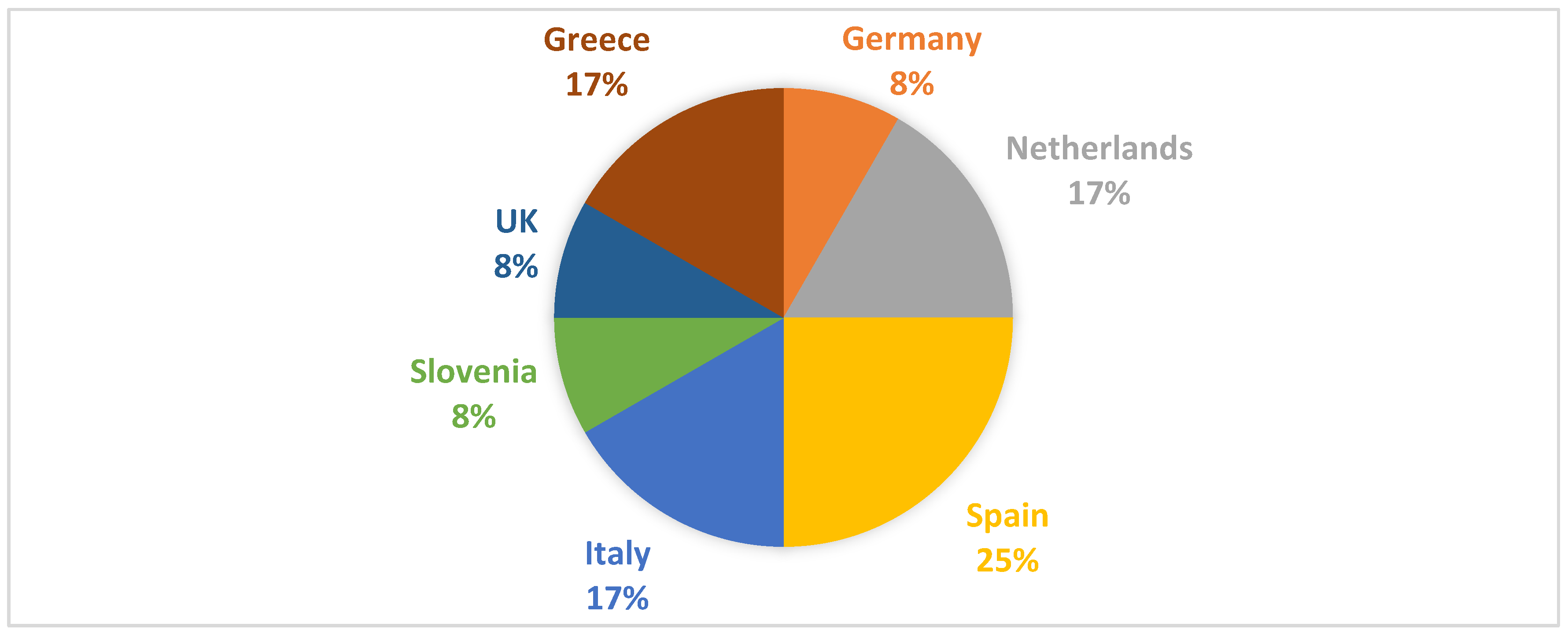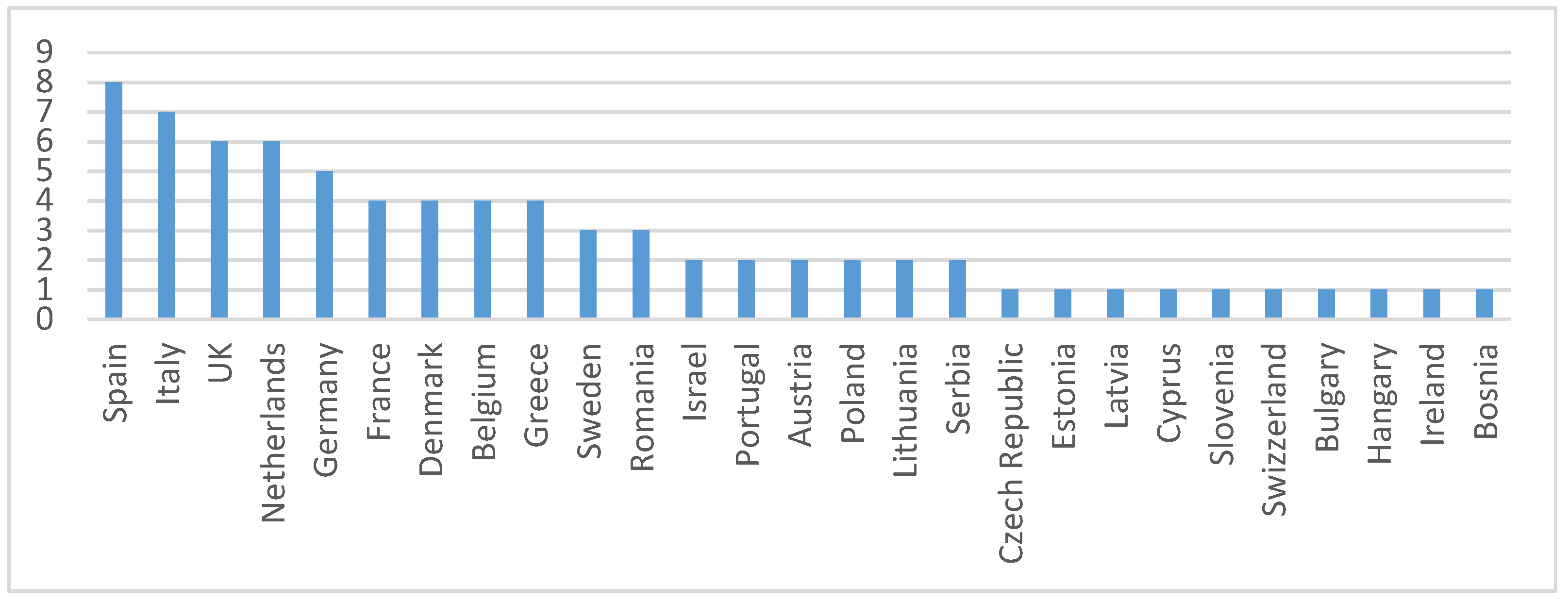How to Improve the Diffusion of Climate-Smart Agriculture: What the Literature Tells us
Abstract
:1. Introduction
2. The Definition of CSA in a General Framework
3. The Literature on CSA and the Barriers for its Diffusion
3.1. Methodology
- (1)
- A predominant search term (“Smart Agriculture”) and other search criteria (“adaptation”, “mitigation”, “policy”);
- (2)
- A time period of publication between 2009 and 2019;
- (3)
- The publication type, such as article, review, or book chapter;
- (4)
- English as the language of publication.
3.2. Results
4. An Analysis of the European Financed Projects
- (a)
- Project acronym;
- (b)
- Years of the project (between 2009–2019);
- (c)
- Organization country;
- (d)
- Domain of application (food and natural resources, climate change and environment).
5. Conclusions
Author Contributions
Funding
Conflicts of Interest
Appendix A
| Project Abbreviation | Project Title | Description |
|---|---|---|
| ECHORD PLUS PLUS | European Clearing House for Open Robotics Development Plus Plus | robotics for vegetable harvest |
| SWEEPER | Sweet Pepper Harvesting Robot | robotics for vegetable harvest |
| VINEROBOT | Vine Yard Robot | robotics for wine production |
| FIGARO | Flexible and Precise Irrigation Platform to Improve Farm Scale Water Productivity | irrigation technology, DSS |
| SYMPHONY | Integrated System Based on Photonic Microresonators and Microfluidic Components for Rapid Detection of Toxins in Milk and Dairy Products | sensors for dairy producers |
| AGROIT | Advanced Farm Management | virtual platform, app |
| FOODIE | Farm-oriented Open Data in Europe | cloud computing |
| AUDITOR | Advanced Multi-Constellation EGNSS Augmentation and Monitoring | GNNS ground based augmentation system |
| 4D4F | Internet of Food and Farms 2020 | mapping, sensor for agri-food |
| IoF 2020 | Data Driven Dairy Decisions for Farmers | technology for breeders |
| RECAP | Reinforcing CAP | big data to improve CAP, respect of law |
| SMART AKIS | Smart Farming Thematic Network | information about new technology in agriculture |
References
- Faurès, J.M.; Bartley, D.; Bazza, M.; Burke, J.; Hoogeveen, J.; Soto, D.; Steduto, P. Climate Smart Agriculture Sourcebook; FAO: Rome, Italy, 2013; Volume 557, Available online: http://www.fao.org/climate-smart-agriculture-sourcebook/en/ (accessed on 25 January 2020).
- Christiaensen, L.; Demery, L.; Kuhl, J. The (evolving) role of agriculture in poverty reduction—An empirical perspective. J. Dev. Econ. 2011, 96, 239–254. [Google Scholar] [CrossRef] [Green Version]
- Lobell, D.B.; Schlenker, W.; Costa-Roberts, J. Climate trends and global crop production since 1980. Science 2011, 333, 616–620. [Google Scholar] [CrossRef] [PubMed] [Green Version]
- Knox, J.; Hess, T.; Daccache, A.; Wheeler, T. Climate change impacts on crop productivity in Africa and South Asia. Environ. Res. Lett. 2012, 7, 034032. [Google Scholar] [CrossRef]
- Rosenzweig, C.; Elliott, J.; Deryng, D.; Ruane, A.C.; Müller, C.; Arneth, A.; Boote, K.J.; Folberth, C.; Glotter, M.; Khabarov, N.; et al. Assessing agricultural risks of climate change in the 21st century in a global gridded crop model intercomparison. Proc. Natl. Acad. Sci. USA 2014, 111, 3268–3273. [Google Scholar] [CrossRef] [Green Version]
- Lobell, D.B.; Gourdji, S.M. The influence of climate change on global crop productivity. Plant Physiol. 2012, 160, 1686–1697. [Google Scholar] [CrossRef] [Green Version]
- Steenwerth, K.L.; Hodson, A.K.; Bloom, A.J.; Carter, M.R.; Cattaneo, A.; Chartres, C.J.; Hartfield, J.L.; Henry, K.; Hopmans, J.W.; Horwath, W.R.; et al. Climate-smart agriculture global research agenda: Scientific basis for action. Agric. Food Secur. 2014, 3, 11. [Google Scholar] [CrossRef] [Green Version]
- Lipper, L.; McCarthy, N.; Zilberman, D.; Asfaw, S.; Branca, G. (Eds.) Climate Smart Agriculture: Building Resilience to Climate Change, 1st ed.; Springer: Cham, Switzerland, 2017; Volume 52. [Google Scholar]
- Food and Agriculture Organization of the United Nations–FAO. Climate-Smart Agriculture and the Sustainable Development Goals: Mapping Interlinkages, Synergies and Trade-offs and Guidelines for Integrated Implementation; FAO: Rome, Italy, 2019. [Google Scholar]
- Karlsson, L.; Naess, L.O.; Nightingale, A.; Thompson, J. ‘Triple wins’ or ‘triple faults’? Analysing the equity implications of policy discourses on climate-smart agriculture (CSA). J. Peasant Stud. 2018, 45, 150–174. [Google Scholar] [CrossRef]
- Totin, E.; Segnon, A.C.; Schut, M.; Affognon, H.; Zougmoré, R.B.; Rosenstock, T.; Thornton, P.K. Institutional perspectives of climate-smart agriculture: A systematic literature review. Sustainability 2018, 10, 1990. [Google Scholar] [CrossRef] [Green Version]
- Chandra, A.; McNamara, K.E.; Dargusch, P. Climate-smart agriculture: Perspectives and framings. Clim. Policy 2018, 18, 526–541. [Google Scholar] [CrossRef]
- Alem, Y.; Eggert, H.; Ruhinduka, R. Improving welfare through climate-friendly agriculture: The case of the system of rice intensification. Environ. Resour. Econ. 2015, 62, 243–263. [Google Scholar] [CrossRef] [Green Version]
- Siedenburg, J.; Martin, A.; McGuire, S. The power of “farmer friendly” financial incentives to deliver climate smart agriculture: A critical data gap. J. Integr. Environ. Sci. 2012, 9, 201–217. [Google Scholar] [CrossRef]
- Fader, M.; Shi, S.; Bloh, W.V.; Bondeau, A.; Cramer, W. Mediterranean irrigation under climate change: More efficient irrigation needed to compensate for increases in irrigation water requirements. HESS 2016, 20, 953–973. [Google Scholar] [CrossRef] [Green Version]
- Wollenberg, E.K. The mitigation pillar of Climate-Smart Agriculture (CSA): Targets and options. Agric. Dev. 2017, 30, 19–22. [Google Scholar]
- Böttcher, H.; Freibauer, A.; Scholz, Y.; Gitz, V.; Ciais, P.; Mund, M.; Wutzler, T.; Schulze, E.D. Setting priorities for land management to mitigate climate change. Carbon Balance Manag. 2012, 7, 5. [Google Scholar] [CrossRef] [PubMed]
- Lipper, L.; Thornton, P.; Campbell, B.M.; Baedeker, T.; Braimoh, A.; Bwalya, M.; Caron, P.; Cattaneo, A.; Garrity, D.; Henry, K.; et al. Climate-smart agriculture for food security. Nat. Clim. Chang. 2014, 4, 1068. [Google Scholar] [CrossRef]
- Lipper, L.; Zilberman, D. A short history of the evolution of the climate smart agriculture approach and its Links to climate change and sustainable agriculture debates. In Climate Smart Agriculture; Springer: Cham, Switzerland, 2018. [Google Scholar]
- Tranfield, D.; Denyer, D.; Smart, P. Towards a methodology for developing evidence-informed management knowledge by means of systematic review. Br. J. Manag. 2003, 14, 207–222. [Google Scholar] [CrossRef]
- Berrang-Ford, L.; Pearce, T.; Ford, J.D. Systematic review approaches for climate change adaptation research. Reg. Environ. Chang. 2015, 15, 755–769. [Google Scholar] [CrossRef] [Green Version]
- Reuters, T. Endnote x7; Thomson Reuters: Philadelphia, PA, USA, 2013. [Google Scholar]
- Long, T.B.; Blok, V.; Coninx, I. Barriers to the adoption and diffusion of technological innovations for climate-smart agriculture in Europe: Evidence from the Netherlands, France, Switzerland and Italy. J. Clean. Prod. 2016, 112, 9–21. [Google Scholar] [CrossRef]
- McCarthy, N.; Lipper, L.; Branca, G. Climate-smart agriculture: Smallholder adoption and implications for climate change adaptation and mitigation. Mitig. Clim. Chang. Agric. Work. Pap. 2011, 3, 1–37. [Google Scholar]
- Bogdanski, A. Integrated food–energy systems for climate-smart agriculture. Agric. Food Secur. 2012, 1, 9. [Google Scholar] [CrossRef] [Green Version]
- Neufeldt, H.; Jahn, M.; Campbell, B.M.; Beddington, J.R.; DeClerck, F.; De Pinto, A.; Gulledge, J.; Hellin, J.; Herrero, M.; Jarvis, A.; et al. Zougmoré. Beyond climate-smart agriculture: Toward safe operating spaces for global food systems. Agric. Food Secur. 2013, 2, 12. [Google Scholar] [CrossRef] [Green Version]
- Harvey, C.A.; Chacón, M.; Donatti, C.I.; Garen, E.; Hannah, L.; Andrade, A.; Bede, L.; Brown, D.; Calle, A.; Chará, J.; et al. Climate-smart landscapes: Opportunities and challenges for integrating adaptation and mitigation in tropical agriculture. Conserv. Lett. 2014, 7, 77–90. [Google Scholar] [CrossRef]
- Wright, H.; Vermeulen, S.; Laganda, G.; Olupot, M.; Ampaire, E.; Jat, M.L. Farmers, food and climate change: Ensuring community-based adaptation is mainstreamed into agricultural programmes. Clim. Dev. 2014, 6, 318–328. [Google Scholar] [CrossRef] [Green Version]
- Peterson, C.A. Local-Level Appraisal of Benefits and Barriers Affecting Adoption of Climate-Smart Agricultural Practices: Ghana; CGIAR Research Program on Climate Change; Agriculture and Food Security (CCAFS): Copenhagen, Denmark, 2014. [Google Scholar]
- Rosenstock, T.; Lamanna, C.; Arslan, A.; Richards, M. What is the scientific basis for climate-smart agriculture? Clim. Chang. Agric. Food Secur. 2015. Available online: http://www.ccardesa.org/knowledge-products/what-scientific-basis-climate-smart-agriculture (accessed on 2 February 2020).
- Ampaire, E.L.; Happy, P.; van Asten, P.; Radeny, M. The Role of Policy in Facilitating Adoption of Climate-Smart Agriculture in Uganda; CGIAR Research Program on Climate Change; Agriculture and Food Security (CCAFS): Copenhagen, Denmark, 2015. [Google Scholar]
- Zougmoré, R.; Partey, S.; Ouédraogo, M.; Omitoyin, B.; Thomas, T.; Ayantunde, A.; Ericksen, P.; Said, M.; Jalloh, A. Toward climate-smart agriculture in West Africa: A review of climate change impacts, adaptation strategies and policy developments for the livestock, fishery and crop production sectors. Agric. Food Secur. 2016, 5, 26. [Google Scholar] [CrossRef]
- Rosenstock, T.S.; Lamanna, C.; Chesterman, S.; Bell, P.; Arslan, A.; Richards, M.; Rioux, J.; Akinleye, A.O.; Champalle, C.; Cheng, Z.; et al. The Scientific Basis of Climate-Smart Agriculture: A Systematic Review Protocol; CCAFS Working Paper; CCAFS: Frederiksberg, Denmark, 2016; Volume 138, Available online: https://ccafs.cgiar.org/publications/scientific-basis-climate-smart-agriculture-systematic-review-protocol#.XvDDLedRWUk (accessed on 2 February 2020).
- Engel, S.; Muller, A. Payments for environmental services to promote “climate-smart agriculture”? Potential and challenges. J. Agric. Econ. 2016, 47, 173–184. [Google Scholar] [CrossRef]
- Khatri-Chhetri, A.; Aggarwal, P.K.; Joshi, P.K.; Vyas, S. Farmers’ prioritization of climate-smart agriculture (CSA) technologies. Agric. Syst. 2017, 151, 184–191. [Google Scholar] [CrossRef]
- Lee, J. Farmer participation in a climate-smart future: Evidence from the Kenya Agricultural Carbon Project. Lands Use Policy 2017, 68, 72–79. [Google Scholar] [CrossRef]
- Sain, G.; Loboguerrero, A.M.; Corner-Dolloff, C.; Lizarazo, M.; Nowak, A.; Martínez-Barón, D.; Andrieu, N. Costs and benefits of climate-smart agriculture: The case of the Dry Corridor in Guatemala. Agric. Syst. 2017, 151, 163–173. [Google Scholar] [CrossRef]
- Andrieu, N.; Sogoba, B.; Zougmore, R.; Howland, F.; Samake, O.; Bonilla-Findji, O.; Lizarazo, M.; Nowak, A.; Dembele, C.; Corner-Dolloff, C.; et al. Prioritizing investments for climate-smart agriculture: Lessons learned from Mali. Agric. Syst. 2017, 154, 13–24. [Google Scholar] [CrossRef] [Green Version]
- Westermann, O.; Förch, W.; Thornton, P.; Körner, J.; Cramer, L.; Campbell, B. Scaling up agricultural interventions: Case studies of climate-smart agriculture. Agric. Syst. 2018, 165, 283–293. [Google Scholar] [CrossRef]
- Senyolo, M.P.; Long, T.B.; Blok, V.; Omta, O. How the characteristics of innovations impact their adoption: An exploration of climate-smart agricultural innovations in South Africa. J. Clean. Prod. 2018, 172, 3825–3840. [Google Scholar] [CrossRef]
- Scherr, S.J.; Shames, S.; Friedman, R. From climate-smart agriculture to climate-smart landscapes. Agric. Food Secur. 2012, 1, 12. [Google Scholar] [CrossRef] [Green Version]
- Dougill, A.J.; Whitfield, S.; Stringer, L.C.; Vincent, K.; Wood, B.T.; Chinseu, E.L.; Steward, P.; Mkwambisi, D.D. Mainstreaming conservation agriculture in Malawi: Knowledge gaps and institutional barriers. J. Environ. Manag. 2017, 195, 25–34. [Google Scholar] [CrossRef] [PubMed]
- Brandt, P.; Kvakić, M.; Butterbach-Bahl, K.; Rufino, M.C. How to target climate-smart agriculture? Concept and application of the consensus-driven decision support framework “targetCSA”. Agric. Syst. 2018, 151, 234–245. [Google Scholar] [CrossRef]
- Scherer, L.; Verburg, P.H. Mapping and linking supply-and demand-side measures in climate-smart agriculture. A review. Agron. Sustain. Dev. 2017, 37, 66. [Google Scholar] [CrossRef] [Green Version]
- Makate, C. Effective scaling of climate smart agriculture innovations in African smallholder agriculture: A review of approaches, policy and institutional strategy needs. Environ. Sci. Policy. 2019, 96, 37–51. [Google Scholar] [CrossRef]
- Millar, J.; Connell, J. Strategies for scaling out impacts from agricultural systems change: The case of forages and livestock production in Laos. Agric. Human Values 2010, 27, 213–225. [Google Scholar] [CrossRef]
- European Commission. Communication from the Commission to the European Parliament, the Council, the European Economic and Social Committee and the Committee of the Regions–The Future of Food and Farming; European Commission: Brussels, Belgium, 2017. [Google Scholar]
- CORDIS. Precision Farming: Sowing the Seeds of a New Agricultural Revolution; European Commission: Brussels, Belgium, 2017; Available online: https://cordis.europa.eu/article/id/400295-precision-farming-sowing-the-seeds-of-a-new-agricultural-revolution (accessed on 16 September 2019).
- ISTAT. Andamento Dell’Economia Agricola, Roma, Report. 2019. Available online: https://www.istat.it/it/files//2020/05/Andamento-economia-agricola-2019.pdf (accessed on 30 March 2020).
- Eurostat. Agriculture, Forestry and Fishery Statistics; Publications Office of the EU: Luxembourg, 2019; Available online: https://ec.europa.eu/eurostat/web/products-statistical-books/-/KS-FK-19-001 (accessed on 30 March 2020).
- Papadopoulos, A.G.; Fratsea, L.M.; Karanikolas, P.; Zografakis, S. Reassembling the Rural: Socio-Economic Dynamics, Inequalities and Resilience in Crisis-Stricken Rural Greece. Sociol. Ruralis. 2019, 59, 474–493. [Google Scholar] [CrossRef]
- Schaafsma, M.; Utila, H.; Hirons, M.A. Understanding trade-offs in upscaling and integrating climate-smart agriculture and sustainable river basin management in Malawi. Environ. Sci. Policy 2018, 80, 117–124. [Google Scholar] [CrossRef] [Green Version]






| Inclusion Criteria | Exclusion Criteria |
|---|---|
| Text in English | Text in languages other than English |
| Publication type is article, review, or book chapter | Publication type is different |
| Linked to the agricultural sector | Linked to other sectors |
| Published in the period (2009–2019) | Published in other periods |
| Addresses at least one of the barriers (economic, institutional, behavioral, organizational, market) | Addresses none of the barriers |
| Barrier Type | Barrier Specification | Source |
|---|---|---|
| Economic | High initial cost | McCarthy et al. [24]; Bogdanski [25]; Siedenburg et al. [15]; Neufeldt et al. [26]; Harvey et al. [27]; Lipper et al. [18]; Steenwerth et al. [7]; Wright et al. [28]; Peterson [29]; Rosenstock et al. [30]; Ampaire et al. [31]; Long et al. [23]; Zougmoré et al. [32]; Rosenstock et al. [33]; Engel [34]; |
| High Implementation cost | ||
| Hidden cost (transactional cost) | ||
| Uncertain returns and results | ||
| Poor Access to Capital | ||
| Temporal asymmetry between costs and benefits | ||
| Long pay-back periods (ROI) | Khatri-Chhetri et al. [35]; Chandra et al. [12]; Lee [36]; Sain et al. [37]; Andrieu et al. [38]; | |
| Over discounting the future | Westermann et al. [39]; Senyolo et al. [40]; | |
| Institutional | Low institutional support | Scherr et al. [41]; Bogdanski [25]; Neufeldt et al. [26]; Harvey et al. [27]; Lipper et al. [18]; Wright et al. [28]; Ampaire et al. [31]; Zougmoré et al. [32]; Dougil et al. [42]; Chandra et al. [12]; Andrieu et al. [38]; Senyolo et al. [40]; |
| Lack of regulatory framework | ||
| Policies and Institutions | ||
| Behavioral | Results/effects of technology difficult to observe | Neufeldt et al. [26]; Harvey et al. [27]; Steenwerth et al. [7]; Peterson [29]; Khatri-Chhetri et al. [35]; Senyolo et al. [40]; |
| Conflict with traditional methods | ||
| Farmers’ beliefs and/or opinions | ||
| Farmers’ level of education | ||
| Lack of management support/awareness | ||
| Organizational | Poor information | Scherr et al. [41]; Neufeldt et al. [26]; Lipper et al. [18]; Steenwerth et al. [7]; Rosenstock et al. [30]; Ampaire et al. [31]; Long et al. [23]; Zougmoré et al. [32]; Rosenstock et al. [33]; Engel [34]; Dougil et al. [42]; Chandra et al. [12]; Senyolo et al. [40]; |
| Inability to assess technologies | ||
| Lack of required competencies/skills required to use technologies | ||
| Market | Uncertainty | McCarthy et al. [24]; Bogdanski [25]; Rosenstock et al. [30]; Brandt et al. [43]; Lee [36]; Scherer et al. [44]; Westermann et al. [39]; |
| Poor information | ||
| Lack of market attractiveness Market not aligned to preferences |
© 2020 by the authors. Licensee MDPI, Basel, Switzerland. This article is an open access article distributed under the terms and conditions of the Creative Commons Attribution (CC BY) license (http://creativecommons.org/licenses/by/4.0/).
Share and Cite
Fusco, G.; Melgiovanni, M.; Porrini, D.; Ricciardo, T.M. How to Improve the Diffusion of Climate-Smart Agriculture: What the Literature Tells us. Sustainability 2020, 12, 5168. https://doi.org/10.3390/su12125168
Fusco G, Melgiovanni M, Porrini D, Ricciardo TM. How to Improve the Diffusion of Climate-Smart Agriculture: What the Literature Tells us. Sustainability. 2020; 12(12):5168. https://doi.org/10.3390/su12125168
Chicago/Turabian StyleFusco, Giulio, Marta Melgiovanni, Donatella Porrini, and Traci Michelle Ricciardo. 2020. "How to Improve the Diffusion of Climate-Smart Agriculture: What the Literature Tells us" Sustainability 12, no. 12: 5168. https://doi.org/10.3390/su12125168
APA StyleFusco, G., Melgiovanni, M., Porrini, D., & Ricciardo, T. M. (2020). How to Improve the Diffusion of Climate-Smart Agriculture: What the Literature Tells us. Sustainability, 12(12), 5168. https://doi.org/10.3390/su12125168






